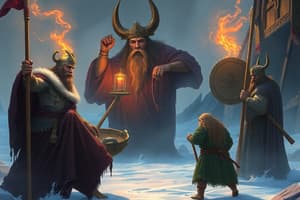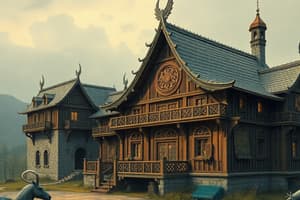Podcast
Questions and Answers
Who were the wealthiest in Viking society?
Who were the wealthiest in Viking society?
- Jarls (correct)
- Thralls
- Karls
- Freemen
Who would have owned Viking longships?
Who would have owned Viking longships?
Jarls
Who would be buried with a Jarl after death?
Who would be buried with a Jarl after death?
Thralls
Who in the social structure took up most of the Viking population?
Who in the social structure took up most of the Viking population?
What were other names for Jarls?
What were other names for Jarls?
Who led Viking raids?
Who led Viking raids?
Who accompanied Jarls on raids?
Who accompanied Jarls on raids?
What was the name of the ship burial site discovered?
What was the name of the ship burial site discovered?
Who was on the Oseberg ship?
Who was on the Oseberg ship?
Who were the farmers, blacksmiths, fishermen, etc. in Viking society?
Who were the farmers, blacksmiths, fishermen, etc. in Viking society?
What is another name for Karls?
What is another name for Karls?
Who in the Viking social structure did NOT have rights to their whereabouts, their work, or to vote?
Who in the Viking social structure did NOT have rights to their whereabouts, their work, or to vote?
What were ways of identifying wealth in Vikings?
What were ways of identifying wealth in Vikings?
Could Karls own slaves?
Could Karls own slaves?
Who was able to vote, go wherever they pleased, and own slaves?
Who was able to vote, go wherever they pleased, and own slaves?
What was the time period of the Viking Age?
What was the time period of the Viking Age?
What was the building strategy used on Viking longships?
What was the building strategy used on Viking longships?
Why did Vikings settle in places they conquered?
Why did Vikings settle in places they conquered?
How many social groups were there in Viking society?
How many social groups were there in Viking society?
How did slaves become slaves?
How did slaves become slaves?
Flashcards are hidden until you start studying
Study Notes
Viking Social Structure
- Jarls were the wealthiest class in Viking society, controlling land and resources.
- Jarls owned Viking longships, crucial for raids and trade expeditions.
- Thralls, or slaves, were often buried with Jarls as part of burial customs.
- Karls made up the majority of the Viking population, including freemen such as farmers and craftsmen.
- Alternative titles for Jarls include nobles and lords, indicating their high status.
- Jarls led Viking raids, showcasing their roles as military leaders.
- Karls accompanied Jarls on these raids, contributing to their success.
- The Oseberg Ship is a notable ship burial site that provides insights into Viking burial practices.
- The Oseberg ship contained the remains of a Jarl woman and a thrall, possibly sacrificed for burial.
- Karls were responsible for various occupations, such as farming, blacksmithing, and fishing.
- Another term for Karls is freemen, highlighting their rights compared to thralls.
- Thralls lacked rights, unable to control their whereabouts, work, or participate in voting.
- Indicators of wealth among Vikings included ownership of slaves, longships, high-quality clothing, and weapons.
- Karls also had the ability to own slaves, enhancing their social standing.
- Both Karls and Jarls had the right to vote, travel freely, and own slaves.
- The Viking Age spanned from 790 to approximately 1066 CE, marking a significant era in history.
- The clinker method was a shipbuilding technique used for Viking longships, providing strength and flexibility.
- Vikings settled in conquered lands to utilize agricultural potential, often familiar with the terrain.
- Viking society was composed of three main social groups: Jarls, Karls, and Thralls.
- Slavery could result from being born into it, or from being captured during raids or trades.
Studying That Suits You
Use AI to generate personalized quizzes and flashcards to suit your learning preferences.




